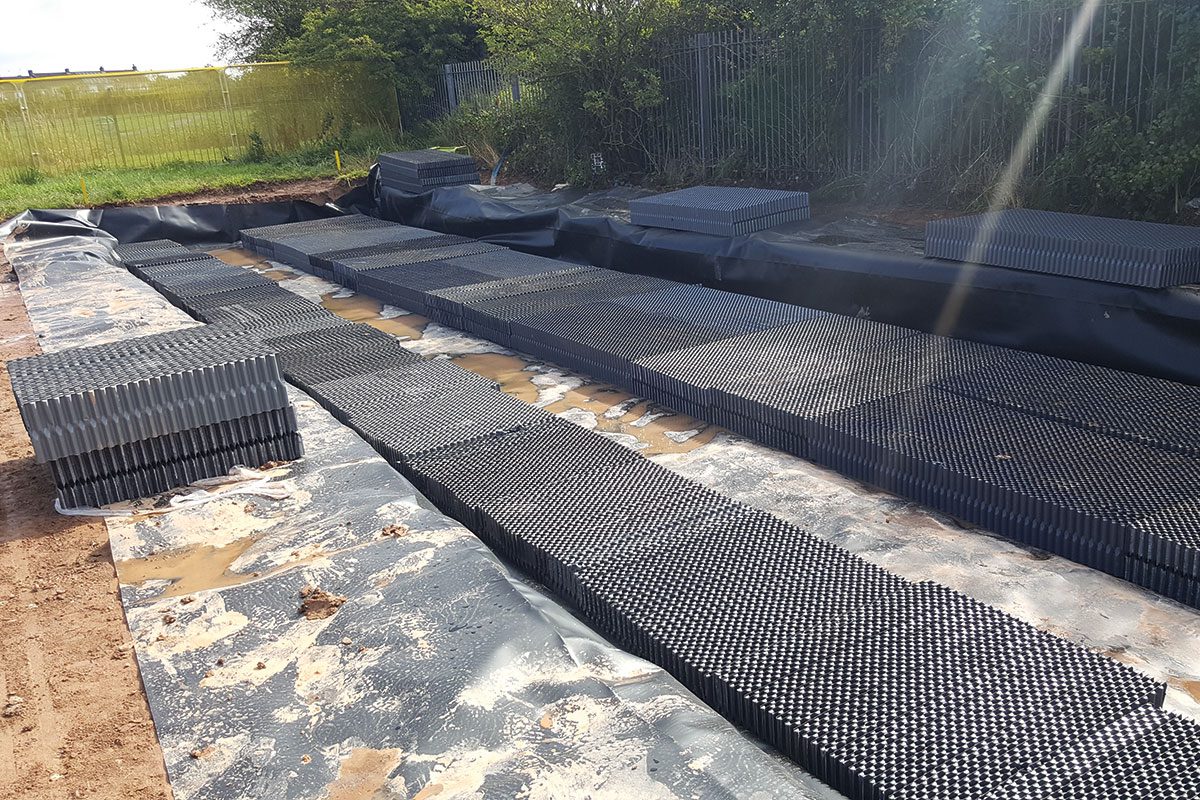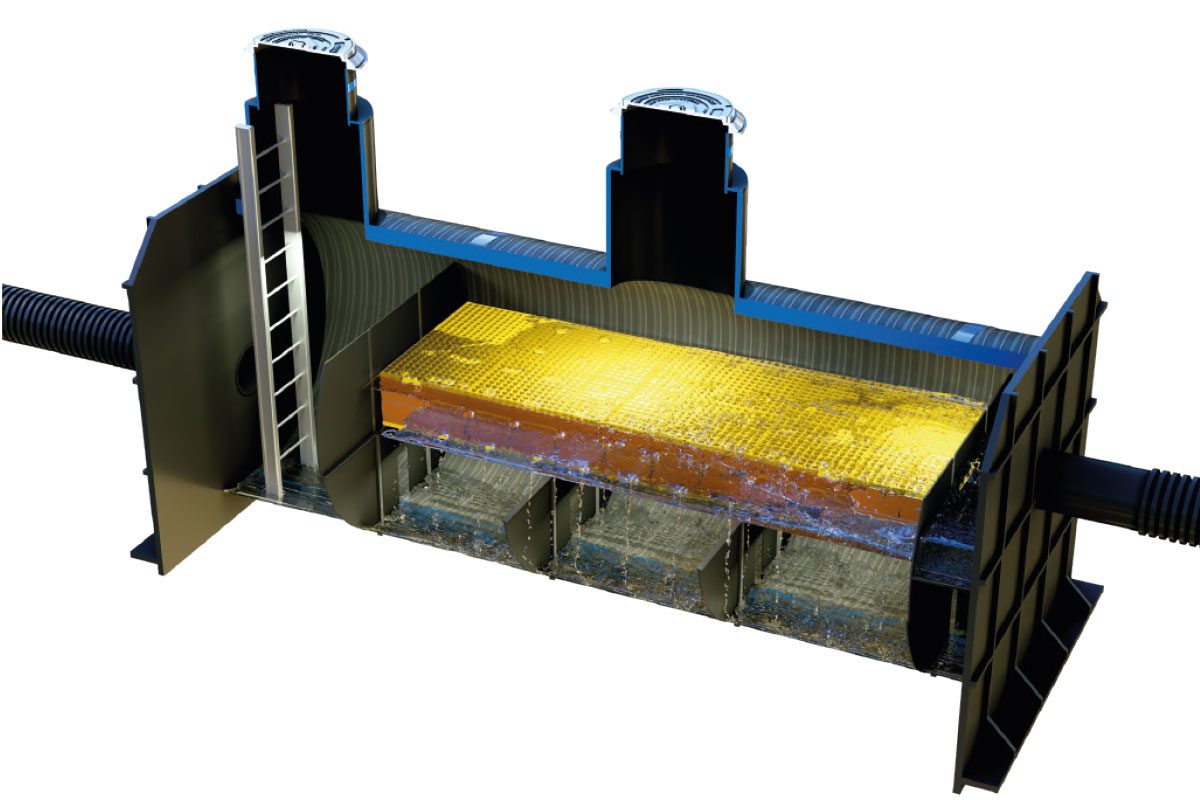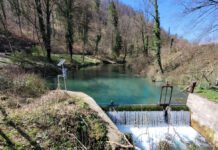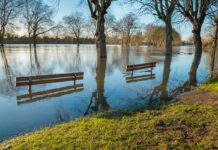The first UK deployment of a new water treatment technology has helped a super-school development in Cardiff achieve a ‘gold standard’ in environmental protection, deemed an important endorsement of the stewardship it is providing for the sensitive natural landscape on its doorstep. Water infrastructure systems specialist SDS writes

The 6.5ha school campus in Rumney to the North East of Cardiff neighbours a Site of Special Scientific Interest (SSSI) that forms part of the Gwent Levels, a protected area flanking the Severn Estuary between Cardiff and Newport. The area is drained by a network of ‘reens’, historic ditches that have been used to reclaim sea-level wetland for pasture.
A robust stormwater management solution, installed by water infrastructure systems specialist SDS Limited as part of the city’s £26million Eastern High School development, included the first installation of the firm’s Aqua-FilterTM filtration system, with the aim of ensuring surface water leaving the site is the cleanest it can be.
The challenges
The development, delivered by contractor Wilmott Dixon, aimed for the highest standards in every aspect of its design and delivery. A multi-functional drainage solution designed by engineers at Cambria Consulting overcame significant challenges to successfully manage both the quality and quantity of surface water runoff within the site.
Ed Hoskins, Senior Associate with Cambria Consulting Ltd, explains: “Redevelopment of the school campus within the existing footprint of the former school site left no space to incorporate any above-ground attenuation or vegetative treatment. The site had shallow falls and lay partly within a designated flood plain. There was 2.3ha of impermeable area together with a groundwater table that provided little opportunity for any infiltration.
“Any discharge from the site needed to be directed through an existing outfall into the highly-sensitive Pil du Reen watercourse, which flows into Caldicott and Wentloog Levels, and eventually into the Severn Channel.”
Natural Resources Wales (NRW) were particularly concerned to ensure the fines and sediments that could be carried in the runoff during construction, especially at times of heavy rain, were prevented from entering the water environment, he added. However, the drainage solution also needed to continue to provide a robust ‘belt and braces’ protection of a sensitive water receptor during the lifetime of the school.
“Natural Resources Wales were particularly concerned to guarantee extremely robust arrangements for pollution control. They simply wanted the best protection possible,” Hoskins stresses.
Sensitive environment
The Pil Du Reen is part of the network of surface water drains or ditches whose levels are controlled to enable livestock to be penned and farmed. In this area of flats and wetlands, and within a functional flood plain, only the lowest possible discharge flow rate was permissible to avoid any potential for disrupting the sensitive ecological balance.
Ensuring the runoff was free from sediment and any attached hydrocarbons was also essential as the Gwent Levels are rich in plant and aquatic life, as well as mammals including otters and water voles and a variety of water birds. The Rumney and Peterstone SSSI itself supports important and rare aquatic plant species and invertebrates.

Treatment
An SDS Aqua-SwirlTM hydrodynamic vortex separator upstream of an SDS Aqua-FilterTM filtration unit were integral to the solution. On the upper portion of the site, runoff from a 79-space car park, delivery service yard and an area designated for the teaching of practical construction skills is treated by the two devices. Water passes first through the Aqua-SwirlTM to capture gross pollutants and hydrocarbons, before being polished by the Aqua-FilterTM to remove finer silts and dissolved pollutants, using filtration media selected by SDS to meet the specific needs of the site.
“A second level of treatment was essential to ensure a very high standard of water quality,” explains Hoskins. “We therefore looked around for alternative solutions and, having found the answer we were looking for, we were delighted to have installed the UK’s very first SDS Aqua-FilterTM.”
Attenuation
Runoff that has passed through the treatment train, together with water from the roof of the school building, is directed to the lower half of the site where outdoor sports facilities are located. Surface water from new rugby and astro turf pitches and a Multi-Use Games Arena (MUGA) also drain into the system.
To ensure attenuation and avoid the potential for flooding up to a 1 in 100-year flood event + 30% allowance for climate change, an SDS GEOlight® stormwater attenuation system was designed to capture and retain stormwater from the entire site. Two tanks, together capable of storing up to 1,950m3 of water, were installed underneath the sports pitches.
Cambria Consulting identified an existing outfall within the site boundary that facilitated connection to a drainage pipe that discharged into the Pil Du Reen. Discharge from the two GEOlight® tanks is regulated by vortex flow controls, with the final discharge from the site restricted to a maximum flow rate of 5 l/s.






